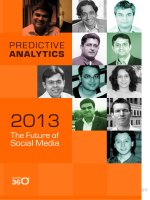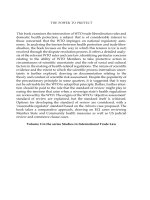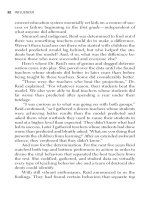Predictive analytics the power to predict who will click buy lie or die 2nd edition (revised)
Bạn đang xem bản rút gọn của tài liệu. Xem và tải ngay bản đầy đủ của tài liệu tại đây (26.02 MB, 387 trang )
WEBFFIRS
12/04/2015
3:47:48
Page viii
WEBFFIRS
12/04/2015
3:47:48
Page i
Praise for Predictive Analytics
“Littered with lively examples . . .”
—The Financial Times
“Readers will find this a mesmerizing and fascinating study. I know I
did! . . . I was entranced by the book.”
—The Seattle Post-Intelligencer
“Siegel is a capable and passionate spokesman with a compelling vision.”
—Analytics Magazine
“A must-read for the normal layperson.”
—Journal of Marketing Analytics
“This book is an operating manual for twenty-first-century life. Drawing
predictions from big data is at the heart of nearly everything, whether it’s in
science, business, finance, sports, or politics. And Eric Siegel is the ideal
guide.”
—Stephen Baker, author, The Numerati and Final Jeopardy: The Story
of Watson, the Computer That Will Transform Our World
“Simultaneously entertaining, informative, and nuanced. Siegel goes behind
the hype and makes the science exciting.”
—Rayid Ghani, Chief Data Scientist,
Obama for America 2012 Campaign
“The most readable (for we laymen) ‘big data’ book I’ve come across. By far.
Great vignettes/stories.”
—Tom Peters, coauthor, In Search of Excellence
“The future is right now—you’re living in it. Read this book to gain
understanding of where we are and where we’re headed.”
—Roger Craig, record-breaking analytical Jeopardy!
champion; Data Scientist, Digital Reasoning
WEBFFIRS
12/04/2015
3:47:48
Page ii
“A clear and compelling explanation of the power of predictive analytics and
how it can transform companies and even industries.”
—Anthony Goldbloom, founder and CEO, Kaggle.com
“The definitive book of this industry has arrived. Dr. Siegel has achieved
what few have even attempted: an accessible, captivating tome on predictive
analytics that is a must-read for all interested in its potential—and peril.”
—Mark Berry, VP, People Insights, ConAgra Foods
“I’ve always been a passionate data geek, but I never thought it might be
possible to convey the excitement of data mining to a lay audience. That is
what Eric Siegel does in this book. The stories range from inspiring to
downright scary—read them and find out what we’ve been up to while you
weren’t paying attention.”
—Michael J. A. Berry, author of Data Mining Techniques, Third Edition
“Eric Siegel is the Kevin Bacon of the predictive analytics world, organizing
conferences where insiders trade knowledge and share recipes. Now, he has
thrown the doors open for you. Step in and explore how data scientists are
rewriting the rules of business.”
—Kaiser Fung, VP, Vimeo; author of Numbers Rule Your World
“Written in a lively language, full of great quotes, real-world examples, and
case studies, it is a pleasure to read. The more technical audience will enjoy
chapters on The Ensemble Effect and uplift modeling—both very hot trends.
I highly recommend this book!”
—Gregory Piatetsky-Shapiro, Editor, KDnuggets;
founder, KDD Conferences
“Exciting and engaging—reads like a thriller! Predictive analytics has its roots
in people’s daily activities and, if successful, affects people’s actions. By way of
examples, Siegel describes both the opportunities and the threats predictive
analytics brings to the real world.”
—Marianna Dizik, Statistician, Google
WEBFFIRS
12/04/2015
3:47:48
Page iii
“A fascinating page-turner about the most important new form of informa
tion technology.”
—Emiliano Pasqualetti, CEO, DomainsBot Inc.
“Succeeds where others have failed—by demystifying big data and providing
real-world examples of how organizations are leveraging the power of
predictive analytics to drive measurable change.”
—Jon Francis, Senior Data Scientist, Nike
“In a fascinating series of examples, Siegel shows how companies have made
money predicting what customers will do. Once you start reading, you will
not be able to put it down.”
—Arthur Middleton Hughes, VP, Database Marketing Institute;
author of Strategic Database Marketing, Fourth Edition
“Excellent. Each chapter makes the complex comprehensible, making heavy
use of graphics to give depth and clarity. It gets you thinking about what else
might be done with predictive analytics.”
—Edward Nazarko, Client Technical Advisor, IBM
“What is predictive analytics? This book gives a practical and up-to-date
answer, adding new dimension to the topic and serving as an excellent
reference.”
—Ramendra K. Sahoo, Senior VP,
Risk Management and Analytics, Citibank
“Competing on information is no longer a luxury—it’s a matter of survival.
Despite its successes, predictive analytics has penetrated only so far, relative to
its potential. As a result, lessons and case studies such as those provided in
Siegel’s book are in great demand.”
—Boris Evelson, VP and Principal Analyst, Forrester Research
“Fascinating and beautifully conveyed. Siegel is a leading thought leader in
the space—a must-have for your bookshelf!”
—Sameer Chopra, Chief Analytics Officer, Orbitz Worldwide
WEBFFIRS
12/04/2015
3:47:48
Page iv
“A brilliant overview—strongly recommended to everyone curious about
the analytics field and its impact on our modern lives.”
—Kerem Tomak, VP of Marketing Analytics, Macys.com
“Eric explains the science behind predictive analytics, covering both the
advantages and the limitations of prediction. A must-read for everyone!”
—Azhar Iqbal, VP and Econometrician,
Wells Fargo Securities, LLC
“Predictive Analytics delivers a ton of great examples across business sectors of
how companies extract actionable, impactful insights from data. Both the
novice and the expert will find interest and learn something new.”
—Chris Pouliot, Director, Algorithms and Analytics, Netflix
“In this new world of big data, machine learning, and data scientists, Eric
Siegel brings deep understanding to deep analytics.”
—Marc Parrish, VP, Membership, Barnes & Noble
“A detailed outline for how we might tame the world’s unpredictability. Eric
advocates quite clearly how some choices are predictably more profitable
than others—and I agree!”
—Dennis R. Mortensen, CEO of Visual Revenue,
former Director of Data Insights at Yahoo!
“This book is an invaluable contribution to predictive analytics. Eric’s
explanation of how to anticipate future events is thought provoking and
a great read for everyone.”
—Jean Paul Isson, Global VP Business Intelligence and Predictive
Analytics, Monster Worldwide; coauthor, Win with Advanced Business
Analytics: Creating Business Value from Your Data
“Predictive analytics is the key to unlocking new value at a previously
unimaginable economic scale. In this book, Siegel explains how, doing an
excellent job to bridge theory and practice.”
—Sergo Grigalashvili, VP of Information Technology,
Crawford & Company
WEBFFIRS
12/04/2015
3:47:48
Page v
“Predictive analytics has been steeped in fear of the unknown. Eric Siegel
distinctively clarifies, removing the mystery and exposing its many benefits.”
—Jane Kuberski, Engineering and Analytics,
Nationwide Insurance
“As predictive analytics moves from fashionable to mainstream, Siegel
removes the complexity and shows its power.”
—Rajeeve Kaul, Senior VP, OfficeMax
“Dr. Siegel humanizes predictive analytics. He blends analytical rigor with
real-life examples with an ease that is remarkable in his field. The book is
informative, fun, and easy to understand. I finished reading it in one sitting. A
must-read . . . not just for data scientists!”
—Madhu Iyer, Marketing Statistician, Intuit
“An engaging encyclopedia filled with real-world applications that should
motivate anyone still sitting on the sidelines to jump into predictive analytics
with both feet.”
—Jared Waxman, Web Marketer at LegalZoom,
previously at Adobe, Amazon, and Intuit
“Siegel covers predictive analytics from start to finish, bringing it to life and
leaving you wanting more.”
—Brian Seeley, Manager, Risk Analytics, Paychex, Inc.
“A wonderful look into the world of predictive analytics from the perspec
tive of a true practitioner.”
—Shawn Hushman, VP, Analytic Insights,
Kelley Blue Book
“A must—Predictive Analytics provides an amazing view of the analytical
models that predict and influence our lives on a daily basis. Siegel makes it a
breeze to understand, for all readers.”
—Zhou Yu, Online-to-Store Analyst, Google
WEBFFIRS
12/04/2015
3:47:48
Page vi
“As our ability to collect and analyze information improves, experts like Eric
Siegel are our guides to the mysteries unlocked and the moral questions that
arise.”
—Jules Polonetsky, Co-Chair and Director, Future of Privacy
Forum; former Chief Privacy Officer, AOL and DoubleClick
“Highly recommended. As Siegel shows in his very readable new book, the
results achieved by those adopting predictive analytics to improve decision
making are game changing.”
—James Taylor, CEO, Decision Management Solutions
“An engaging, humorous introduction to the world of the data scientist.
Dr. Siegel demonstrates with many real-life examples how predictive analytics
makes big data valuable.”
—David McMichael, VP, Advanced Business Analytics
“An excellent exposition on the next generation of business intelligence—
it’s really mankind’s latest quest for artificial intelligence.”
—Christopher Hornick, President and CEO,
HBSC Strategic Services
WEBFFIRS
12/04/2015
3:47:48
Page vii
WEBFFIRS
12/04/2015
3:47:48
Page viii
WEBFFIRS
12/04/2015
3:47:49
Page ix
3GFFIRS
08/26/2016
21:37:27
Page x
Cover image: Winona Nelson
Cover design: Wiley
Interior image design: Matt Kornhaas
Copyright 2016 by Eric Siegel. All rights reserved.
Published by John Wiley & Sons, Inc., Hoboken, New Jersey.
Published simultaneously in Canada.
Jeopardy! is a registered trademark of Jeopardy Productions, Inc.
No part of this publication may be reproduced, stored in a retrieval system, or transmitted in any form or by
any means, electronic, mechanical, photocopying, recording, scanning, or otherwise, except as permitted
under Section 107 or 108 of the 1976 United States Copyright Act, without either the prior written permission
of the Publisher, or authorization through payment of the appropriate per-copy fee to the Copyright Clearance
Center, 222 Rosewood Drive, Danvers, MA 01923, (978) 750–8400, fax (978) 646–8600, or on the Web
at www.copyright.com. Requests to the Publisher for permission should be addressed to the Permissions
Department, John Wiley & Sons, Inc., 111 River Street, Hoboken, NJ 07030, (201) 748–6011,
fax (201) 748–6008, or online at www.wiley.com/go/permissions.
Limit of Liability/Disclaimer of Warranty: While the publisher and author have used their best efforts in
preparing this book, they make no representations or warranties with the respect to the accuracy or
completeness of the contents of this book and specifically disclaim any implied warranties of merchantability or
fitness for a particular purpose. No warranty may be created or extended by sales representatives or written sales
materials. The advice and strategies contained herein may not be suitable for your situation. You should consult
with a professional where appropriate. Neither the publisher nor the author shall be liable for damages arising
herefrom.
For general information about our other products and services, please contact our Customer Care
Department within the United States at (800) 762–2974, outside the United States at (317) 572–3993 or
fax (317) 572–4002.
Library of Congress Cataloging-in-Publication Data:
Names: Siegel, Eric, 1968Title: Predictive analytics : the power to predict who will click, buy, lie,
or die / Eric Siegel.
Description: Revised and Updated Edition. | Hoboken : Wiley, 2016. | Revised
edition of the author’s Predictive analytics, 2013. | Includes index.
Identifiers: LCCN 2015031895 (print) | LCCN 2015039877 (ebook) |
ISBN 9781119145677 (paperback) | ISBN 9781119145684 (pdf) |
ISBN 9781119153658 (epub)
Subjects: LCSH: Social sciences—Forecasting. | Economic forecasting |
Prediction (Psychology) | Social prediction. | Human behavior. | BISAC:
BUSINESS & ECONOMICS / Consumer Behavior. | BUSINESS & ECONOMICS /
Econometrics. | BUSINESS & ECONOMICS / Marketing / General.
Classification: LCC H61.4 .S54 2016 (print) | LCC H61.4 (ebook) | DDC
303.49—dc23
LC record available at />Printed in the United States of America
10
9
8 7
6 5
4 3
2 1
WEBFFIRS
12/04/2015
3:47:49
Page xi
This book is dedicated with all my heart to my mother,
Lisa Schamberg, and my father, Andrew Siegel.
WEBFFIRS
12/04/2015
3:47:49
Page xii
WEBFTOC
12/04/2015
3:57:45
Page xiii
Contents
Foreword Thomas H. Davenport
xvii
Preface to the Revised and Updated Edition
What’s new and who’s this book for—the Predictive
Analytics FAQ
xxi
Preface to the Original Edition
What is the occupational hazard of predictive analytics?
xxix
Introduction
The Prediction Effect
How does predicting human behavior combat risk, fortify healthcare,
toughen crime fighting, boost sales, and cut costs? Why must a
computer learn in order to predict? How can lousy predictions be
extremely valuable? What makes data exceptionally exciting? How is
data science like porn? Why shouldn’t computers be called computers?
Why do organizations predict when you will die?
Chapter 1
Liftoff! Prediction Takes Action (deployment)
How much guts does it take to deploy a predictive model into field
operation, and what do you stand to gain? What happens when a man
invests his entire life savings into his own predictive stock market
trading system?
xiii
1
23
3GFTOC
08/26/2016
xiv
21:42:38
Page xiv
Contents
Chapter 2
With Power Comes Responsibility: Hewlett-Packard,
Target, the Cops, and the NSA Deduce Your Secrets (ethics)
How do we safely harness a predictive machine that can foresee job
resignation, pregnancy, and crime? Are civil liberties at risk? Why
does one leading health insurance company predict policyholder death?
Two extended sidebars reveal: 1) Does the government undertake
fraud detection more for its citizens or for self-preservation, and 2) for
what compelling purpose does the NSA need your data even if you
have no connection to crime whatsoever, and can the agency use
machine learning supercomputers to fight terrorism without endangering human rights?
Chapter 3
The Data Effect: A Glut at the End of the Rainbow (data)
We are up to our ears in data, but how much can this raw material really
tell us? What actually makes it predictive? What are the most bizarre
discoveries from data? When wefind an interestinginsight,why arewe
often better off not asking why? In what way is bigger data more
dangerous? How do we avoid being fooled by random noise and ensure
scientific discoveries are trustworthy?
Chapter 4
The Machine That Learns: A Look inside Chase’s
Prediction of Mortgage Risk (modeling)
What form of risk has the perfect disguise? How does prediction
transform risk to opportunity? What should all businesses learn from
insurance companies? Why does machine learning require art in
addition to science? What kind of predictive model can be understood
by everyone? How can we confidently trust a machine’s predictions?
Why couldn’t prediction prevent the global financial crisis?
47
103
147
WEBFTOC
12/04/2015
3:57:45
Page xv
Contents
Chapter 5
The Ensemble Effect: Netflix, Crowdsourcing, and
Supercharging Prediction (ensembles)
To crowdsource predictive analytics—outsource it to the public at
large—a company launches its strategy, data, and research discoveries
into the public spotlight. How can this possibly help the company
compete? What key innovation in predictive analytics has crowdsourc
ing helped develop? Must supercharging predictive precision involve
overwhelming complexity, or is there an elegant solution? Is there
wisdom in nonhuman crowds?
Chapter 6
Watson and the Jeopardy! Challenge (question answering)
How does Watson—IBM’s Jeopardy!-playing computer—work?
Whydoesitneedpredictivemodelinginordertoanswer questions, and
what secret sauce empowers its high performance? How does the
iPhone’s Siri compare? Why is human language such a challenge for
computers? Is artificial intelligence possible?
Chapter 7
Persuasion by the Numbers: How Telenor, U.S. Bank,
and the Obama Campaign Engineered Influence (uplift)
What is the scientific key to persuasion? Why does some marketing
fiercely backfire? Why is human behavior the wrong thing to predict?
What should all businesses learn about persuasion from presidential
campaigns? What voter predictions helped Obama win in 2012 more
than thedetectionofswingvoters? Howcoulddoctors killfewerpatients
inadvertently? How is a person like a quantum particle? Riddle:
What often happens to you that cannot be perceived and that you can’t
even be sure has happened afterward—but that can be predicted in
advance?
xv
185
207
251
WEBFTOC
12/04/2015
3:57:45
Page xvi
xvi
Contents
Afterword
291
Eleven Predictions for the First Hour of 2022
Appendices
A. The Five Effects of Prediction
295
B. Twenty Applications of Predictive Analytics
296
C. Prediction People—Cast of “Characters”
300
Hands-On Guide
303
Resources for Further Learning
Acknowledgments
307
About the Author
311
Index
313
Also see the Central Tables (color insert) for a cross-industry compendium
of 182 examples of predictive analytics.
This book’s Notes—120 pages of citations and comments pertaining to the
chapters above—are available online at www.PredictiveNotes.com.
WEBFBETW
12/04/2015
3:40:24
Page xvii
Foreword
This book deals with quantitative efforts to predict human behavior. One of
the earliest efforts to do that was in World War II. Norbert Wiener, the
father of “cybernetics,” began trying to predict the behavior of German
airplane pilots in 1940—with the goal of shooting them from the sky. His
method was to take as input the trajectory of the plane from its observed
motion, consider the pilot’s most likely evasive maneuvers, and predict
where the plane would be in the near future so that a fired shell could hit it.
Unfortunately, Wiener could predict only one second ahead of a plane’s
motion, but 20 seconds of future trajectory were necessary to shoot down a
plane.
In Eric Siegel’s book, however, you will learn about a large number of
prediction efforts that are much more successful. Computers have gotten a
lot faster since Wiener’s day, and we have a lot more data. As a result, banks,
retailers, political campaigns, doctors and hospitals, and many more organi
zations have been quite successful of late at predicting the behavior of
particular humans. Their efforts have been helpful at winning customers,
elections, and battles with disease.
My view—and Siegel’s, I would guess—is that this predictive activity has
generally been good for humankind. In the context of healthcare, crime, and
terrorism, it can save lives. In the context of advertising, using predictions is
more efficient and could conceivably save both trees (for direct mail and
catalogs) and the time and attention of the recipient. In politics, it seems to
reward those candidates who respect the scientific method (some might
disagree, but I see that as a positive).
xvii
WEBFBETW
12/04/2015
xviii
3:40:24
Page xviii
Foreword
However, as Siegel points out—early in the book, which is admirable—
these approaches can also be used in somewhat harmful ways. “With great
power comes great responsibility,” he notes in quoting Spider-Man. The
implication is that we must be careful as a society about how we use
predictive models, or we may be restricted from using and benefiting from
them. Like other powerful technologies or disruptive human innovations,
predictive analytics is essentially amoral and can be used for good or evil. To
avoid the evil applications, however, it is certainly important to understand
what is possible with predictive analytics, and you will certainly learn that if
you keep reading.
This book is focused on predictive analytics, which is not the only type of
analytics, but the most interesting and important type. I don’t think we need
more books anyway on purely descriptive analytics, which only describe the
past and don’t provide any insight as to why it happened. I also often refer in
my own writing to a third type of analytics—“prescriptive”—that tells its
users what to do through controlled experiments or optimization. Those
quantitative methods are much less popular, however, than predictive
analytics.
This book and the ideas behind it are a good counterpoint to the work of
Nassim Nicholas Taleb. His books, including The Black Swan, suggest that
many efforts at prediction are doomed to fail because of randomness and the
inherent unpredictability of complex events. Taleb is no doubt correct that
some events are black swans that are beyond prediction, but the fact is that
most human behavior is quite regular and predictable. The many examples
that Siegel provides of successful prediction remind us that most swans are
white.
Siegel also resists the blandishments of the “big data” movement.
Certainly some of the examples he mentions fall into this category—data
that is too large or unstructured to be easily managed by conventional
relational databases. But the point of predictive analytics is not the relative
size or unruliness of your data, but what you do with it. I have found that
“big data often equals small math,” and many big data practitioners are
content just to use their data to create some appealing visual analytics. That’s
not nearly as valuable as creating a predictive model.
WEBFBETW
12/04/2015
3:40:24
Page xix
Foreword
xix
Siegel has fashioned a book that is both sophisticated and fully accessible to
the non-quantitative reader. It’s got great stories, great illustrations, and an
entertaining tone. Such non-quants should definitely read this book, because
there is little doubt that their behavior will be analyzed and predicted
throughout their lives. It’s also quite likely that most non-quants will
increasingly have to consider, evaluate, and act on predictive models at work.
In short, we live in a predictive society. The best way to prosper in it is to
understand the objectives, techniques, and limits of predictive models. And
the best way to do that is simply to keep reading this book.
—Thomas H. Davenport
Thomas H. Davenport is the President’s
Distinguished Professor at Babson College,
a fellow of the MIT Center for Digital Business,
Senior Advisor to Deloitte Analytics,
and cofounder of the International Institute for Analytics.
He is the coauthor of Competing on Analytics,
Big Data @ Work, and several other books on analytics.
WEBFBETW
12/04/2015
3:40:24
Page xx
WEBFREVPREF
12/04/2015
3:57:4
Page xxi
Preface to the Revised and
Updated Edition
What’s New and Who’s This Book for—
The Predictive Analytics FAQ
Data Scientist: The Sexiest Job of the Twenty-first Century
—Title of a Harvard Business Review article by
Thomas Davenport and DJ Patil, who in 2015
became the first U.S. Chief Data Scientist
Prediction is booming. It reinvents industries and runs the world.
More and more, predictive analytics (PA) drives commerce, manufactur
ing, healthcare, government, and law enforcement. In these spheres, organi
zations operate more effectively by way of predicting behavior—i.e., the
outcome for each individual customer, employee, patient, voter, and suspect.
Everyone’s doing it. Accenture and Forrester both report that PA’s
adoption has more than doubled in recent years. Transparency Market
Research projects the PA market will reach $6.5 billion within a few years.
A Gartner survey ranked business intelligence and analytics as the current
number one investment priority of chief information officers. And in a
Salesforce.com study, PA showed the highest growth rate of all sales tech
trends, more than doubling its adoption in the next 18 months. Highperformance sales teams are four times more likely to already be using PA
than underperformers.
xxi
WEBFREVPREF
xxii
12/04/2015
3:57:4
Page xxii
Preface to the Revised and Updated Edition
I am a witness to PA’s expanding deployment across industries. Predictive
Analytics World (PAW), the conference series I founded, has hosted over
10,000 attendees since its launch in 2009 and is expanding well beyond its
original PAW Business events. With the expert assistance of industry partners,
we’ve launched the industry-focused events PAW Government, PAW
Healthcare, PAW Financial, PAW Workforce, and PAW Manufacturing,
events for senior executives, and the news site The Predictive Analytics Times.
Since the publication of this book’s first edition in 2013, I have been
commissioned to deliver keynote addresses in each of these industries: market
ing, market research, e-commerce, financial services, insurance, news media,
healthcare, pharmaceuticals, government, human resources, travel, real estate,
construction, and law, plus executive summits and university conferences.
Want a future career in futurology? The demand is blowing up.
McKinsey forecasts a near-term U.S. shortage of 140,000 analytics experts
and 1.5 million managers “with the skills to understand and make decisions
based on analysis of big data.” LinkedIn’s number one “Hottest Skills That
Got People Hired” is “statistical analysis and data mining.”
PA is like Moneyball for . . . money.
Frequently Asked Questions about
Predictive Analytics
Who is this book for?
Everyone. It’s easily understood by all readers. Rather than a how-to for
hands-on techies, the book serves lay readers, technology enthusiasts,
executives, and analytics experts alike by covering new case studies and
the latest state-of-the-art techniques.
Is the idea of predictive analytics hard to understand?
Not at all. The heady, sophisticated notion of learning from data to predict may
sound beyond reach, but breeze through the short Introduction chapter and
you’ll see: The basic idea is clear, accessible, and undeniably far-reaching.
WEBFREVPREF
12/04/2015
3:57:4
Page xxiii
Preface to the Revised and Updated Edition
xxiii
Is this book a how-to?
No, it is a conceptually complete, substantive introduction and industry
overview.
Not a how-to? Then why should techies read it?
Although this mathless introduction is understandable by any reader—
including those with no technical background—here’s why it also affords
value for would-be and established hands-on practitioners:
• A great place to start—provides prerequisite conceptual knowledge
for those who will go on to learn the hands-on practice or will serve in
an executive or management role in the deployment of PA.
• Detailed case studies—explores the real-world deployment of PA by
Chase, IBM, HP, Netflix, the NSA, Target, U.S. Bank, and more.
• A compendium of 182 mini-case studies—the Central Tables,
divided into nine industry groups, include examples from BBC,
Citibank, ConEd, Facebook, Ford, Google, the IRS, Match.com,
MTV, PayPal, Pfizer, Spotify, Uber, UPS, Wikipedia, and more.
• Advanced, cutting-edge topics—the last three chapters introduce
subfields new even to many senior experts: Ensemble models, IBM Watson’s
question answering, and uplift modeling. No matter how experienced you
are, starting with a conceptually rich albeit non-technical overview may
benefit you more than you’d expect—especially for uplift modeling. The
Notes for these three chapters then provide comprehensive references to
technically deep sources (available at www.PredictiveNotes.com).
• Privacy and civil liberties—the second chapter tackles the particular
ethical concerns that arise when harnessing PA’s power.
• Holistic industry overview—the book extends more broadly than a
standard technology introduction—all of the above adds up to a survey of
the field that sheds light on its societal, commercial, and ethical context.
That said, burgeoning practitioners who wish to jump directly to a more
traditional, technically in-depth or hands-on treatment of this topic should









